Wimbledon 2016: The anatomy of championship point
- Published
Wimbledon: Championship points from Murray, McEnroe, Graf and Sampras
"You just do the normal things in that moment - towel yourself down, look for the two best balls and get ready. But your heart is pounding in your chest that much faster, the adrenaline takes over.
"I looked down at my left hand. For the first time I could remember in the middle of a tennis match, it was shaking. Shaking pretty violently.
"I sensed that if I lost this point it might all be over, the opportunity completely gone."
In tennis, not all points are created equal. There are big points in matches - at 30-30, at deuce, at game point - and there are big points in lives, points where wobbling nerves turn into real physical tremors.
That was what Andy Murray discovered before, at the fourth time of asking, converting match point against Novak Djokovic in the 2013 Wimbledon final.
The moment Murray won Wimbledon
So, how do you play the biggest point of your life? Wimbledon's official data supplier IBM has crunched the numbers on the past 12 years of championship points in Wimbledon men's and women's finals to tell us more.
First serve
The finish line is one clean connection and a fraction of a second away.
The serve is the only shot you play on your own terms. It is the opportunity for a clean kill, to escape the tension, seize your chance and snuff out your opponent.
You bounce the ball, cut out the crowd and try to strip Centre Court down to a familiar pattern of lines.
One last look down the other end. Toss the ball overhead and, as it hangs at the apex of its arc, swat it down towards destiny.
It is an intense situation. And one that men and women react to differently.
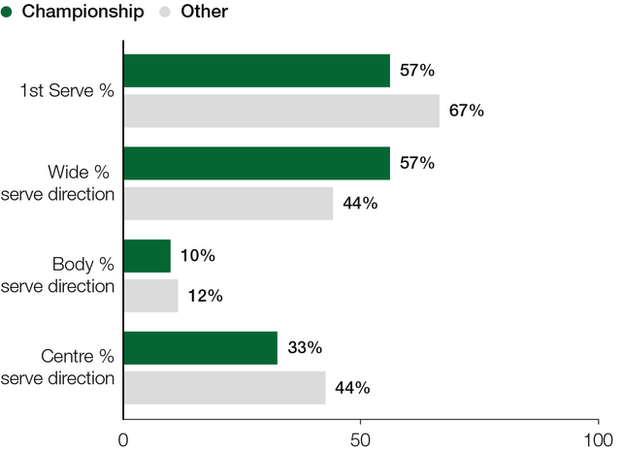
Men's serve stats in Wimbledon finals since 2004
On championship point in the men's final, the first serve finds the mark 57% of the time. That compares to a hit rate of 67% for other points in the final.
In the women's final, however, the trend is in the opposite direction.
When it comes to championship point, their accuracy jumps, with 86% of first serves landing in play compared with 65% through the rest of the match.
The contrast may be different calculations of risk and reward.
Men hit more aces than women. Milos Raonic leads the men's tournament stats, having hit 137 at this year's Wimbledon.
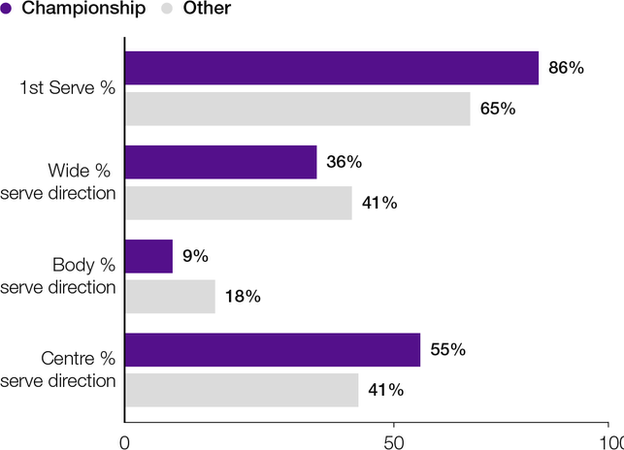
Women's serve stats in Wimbledon finals since 2004
Serena Williams, owner of the most fearsome serve in the history of the women's game, has chalked up 61. Russian Elena Vesnina, second in that category, managed just 31.
The jackpot of ending the match in one stroke is tantalisingly close for the men. It is not desperation but simple logic that dictates they go for broke.
For women players, an ace is a more distant prospect. Instead, exposing your second serve on such a crucial point becomes the greater concern.
There is also a gender divide on where to hit your serve on championship point. It seems men shift their sights out wide - possibly hoping if their opponent does claw back a return they will be open to the classic sucker-punch shot across court.
However, serving out wide is another high-risk, high-reward option. If a receiving player is able to hit an attacking shot, angles have opened up for them across court or down the line.
Women - generally more vulnerable to a counter - are instead more likely to go down the middle which ensures are well positioned for the third shot of the rally.
Second serve
Your first serve has missed.
The possibility of a double fault - your chances ended at your hand - looms.
Your priority now is to make sure you engage the enemy. Slice, spin and kick are all decorations. The ball just has to clear the net and land in the service box.
Under the crushing pressure of championship point, both men and women make doubly sure of at least getting into a rally on second serve.
Men's second serves average 92.3mph on championship point - 4.4mph down on the rest of the final.

Men's second serve speed in Wimbledon finals since 2004
The drop-off in pace in women's second serves is even more pronounced. At 79.7mph, their second serve is 10% shy of what it registered in the rest of the final.

Women's second serve speed in Wimbledon finals since 2004
Into a rally
The point is live. You and your opponent are fighting for space, angles and depth over a 78ft-long strip of hallowed grass.
How aggressive can you be? Do you seize the day and go for a winner? Or play it safer and hope your opponent crumbles first and concedes an error?
Yet again it seems men opt for the more aggressive mindset.
Rallies on championship point in their finals are shorter than those in the rest of the final, perhaps reduced by that death-or-glory approach to serving.

Men's rally length in Wimbledon finals since 2004
In the women's finals, play tends to continue for a whole shot longer on championship point.

Women's rally length in Wimbledon finals since 2004
The final shot
What is the shot that clears the net, lands in and never comes back, the last one this side of lifting the trophy?
There are no easy answers here.
Women's winning moments | ||||
|---|---|---|---|---|
Service winner | Groundstroke winner | Volley winner | Opponent into the net | Opponent wide/long |
3 | 2 | 1 | 3 | 3 |
It comes in all shapes and sizes. And there is no tactic to favour on gender grounds.
Over the past 12 years, Venus Williams, Marion Bartoli and Petra Kvitova won titles with unreturnable serves, bettering the total managed by the men over the same span.
Men's winning moments | ||||
|---|---|---|---|---|
Service winner | Groundstroke winner | Volley winner | Opponent into the net | Opponent wide/long |
2 | 2 | 1 | 2 | 5 |
Celebration
Years of training, a fortnight of graft and a lifetime of dreaming have crystallised in this one moment.
You have conquered the highest summit in the game. Your name is now indelibly added to a roll call of champions stretching back to 1877.
And, after wrestling to keep control of mind and body through pressure and fatigue, you have won.
How do you react?
The classic image of the Wimbledon champion spread-eagled in ecstasy on Centre Court has become rarer in recent years.
After five of the previous six winners celebrated be getting up close and personal with the Wimbledon turf, in the past three men's finals the winner has stayed standing.
Men's Wimbledon champions | ||
|---|---|---|
Year | Champion | Celebration |
2015 | Novak Djokovic | Standing, fist pump |
2014 | Novak Djokovic | Standing, arms aloft |
2013 | Andy Murray | Walking, fist pump |
2012 | Roger Federer | Fall to the floor |
2011 | Novak Djokovic | Fall to the floor |
2010 | Rafael Nadal | Fall to the floor |
2009 | Roger Federer | Jumps and runs to net |
2008 | Rafael Nadal | Falls to the floor |
2007 | Roger Federer | Falls to the floor |
In the women's game, the trend never really caught on, with only two of the past 10 winners ending up on the floor.
Instead, four different players have knelt in celebration in the past 10 years - a winning pose absent from the past decade of men's finals.
Women's winners | ||
|---|---|---|
Year | Champion | Celebrations |
2015 | Serena Williams | Walks to net |
2014 | Petra Kvitova | Fall to floor |
2013 | Marion Bartoli | Drops to knees |
2012 | Serena Williams | Fall to floor |
2011 | Petra Kvitova | Drops to knees |
2010 | Serena Williams | Standing, racquet thrown |
2009 | Serena Williams | Drops to knees |
2008 | Venus Williams | Standing, arms aloft |
2007 | Venus Williams | Standing, arms aloft |
2006 | Amelie Mauresmo | Drops to knees |
After the pleasantries at the net, it is no longer necessary to scale the commentary box rooftops - as Pat Cash famously did after winning in 1987 - to get to friends and family in the players' box.
Wimbledon installed a gate in 2014 to allow champions a less perilous route to their connections.
Novak Djokovic has shown you can always start new traditions. The three-time champion has chewed the Centre Court cud after each of his triumphs, picking some blades of grass to eat.
He also danced with Serena Williams at last year's Champions Dinner in a nod to the previously customary twirl with the women's champion.
Graphics by Michael Milner
- Published6 July 2016

- Published8 July 2016
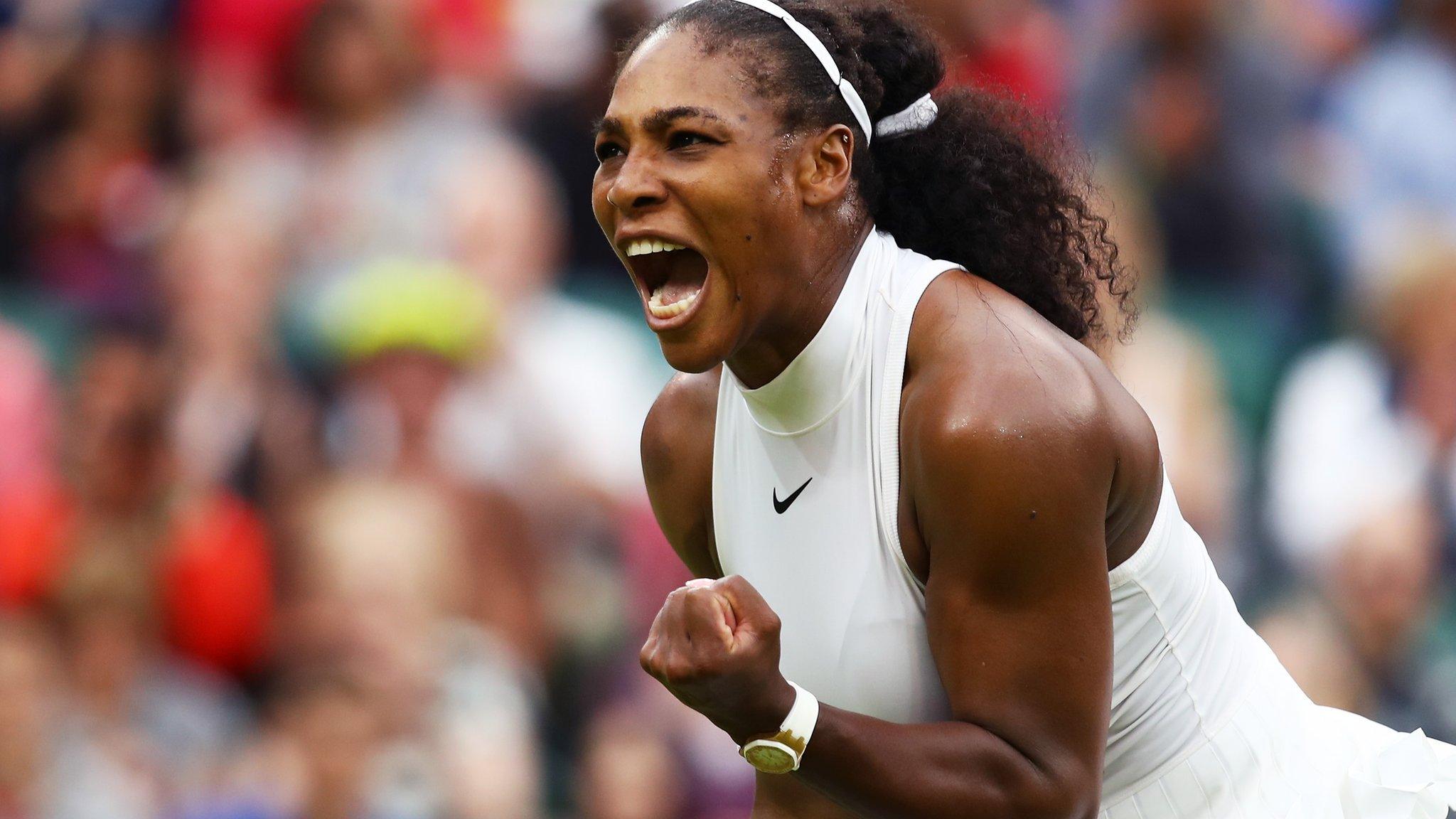
- Published8 July 2016

- Published8 July 2016
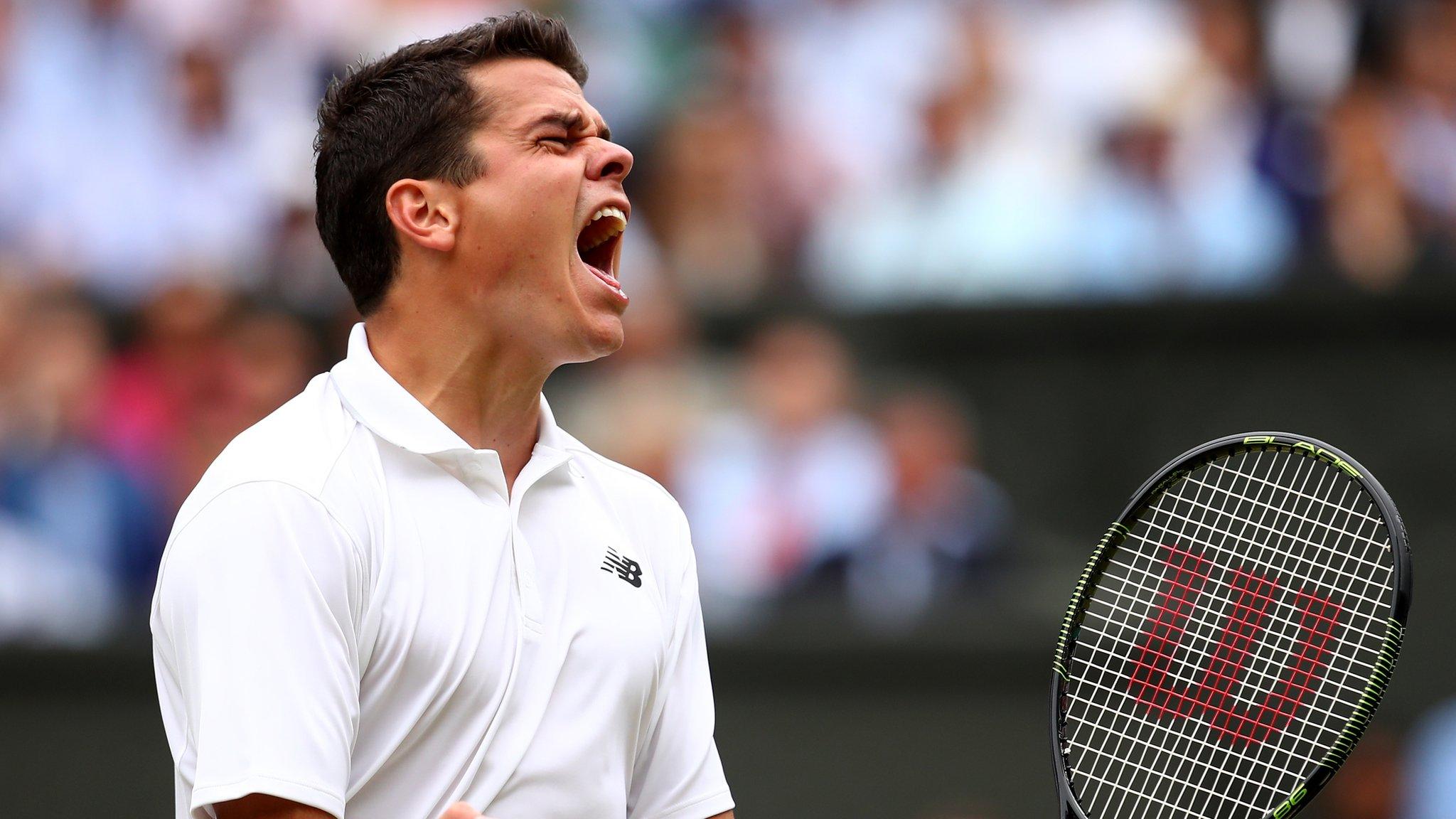
- Published8 November 2016

- Published9 November 2016

- Published17 June 2019
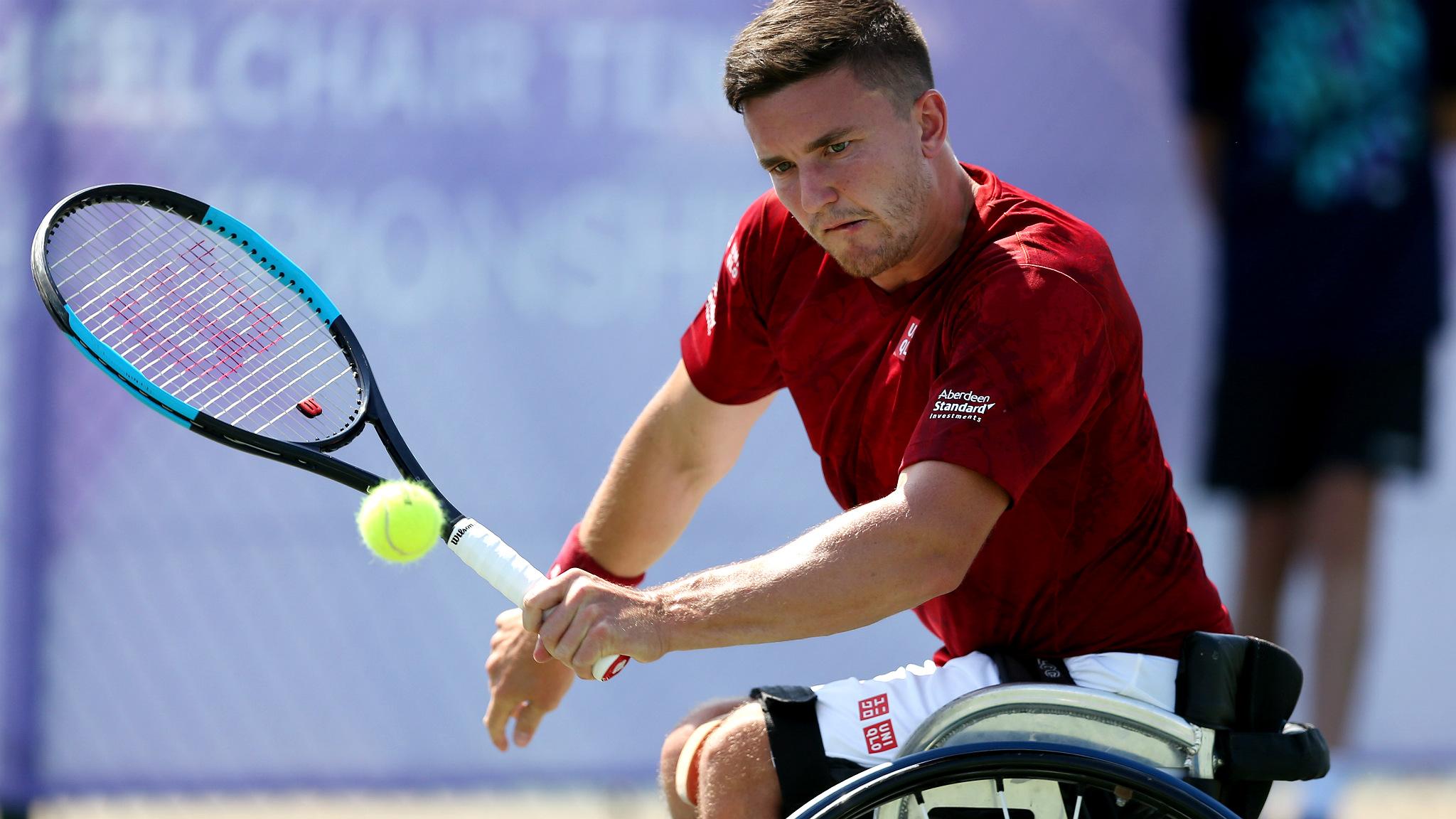
- Published8 August 2017

- Published13 May 2016

- Published19 July 2016
